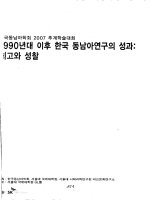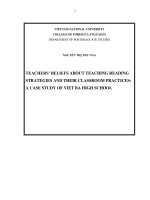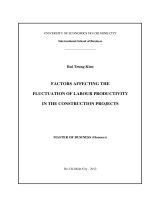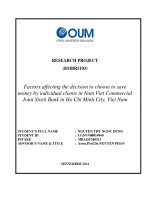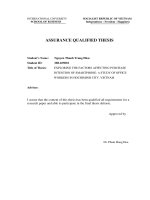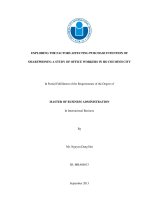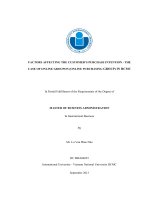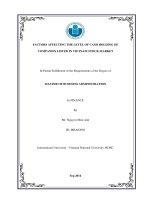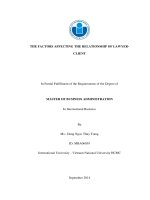FACTORS AFFECTING THE FLUCTUATION OF LABOUR PRODUCTIVITY IN THE CONSTRUCTION PROJECTS
Bạn đang xem bản rút gọn của tài liệu. Xem và tải ngay bản đầy đủ của tài liệu tại đây (418.57 KB, 92 trang )
UNIVERSITY OF ECONOMICS HO CHI MINH CITY
International School of Business
Bui Trung Kien
FACTORS AFFECTING THE
FLUCTUATION OF LABOUR PRODUCTIVITY
IN THE CONSTRUCTION PROJECTS
MASTER OF BUSINESS (Honours)
Ho Chi Minh City - 2012
UNIVERSITY OF ECONOMICS HO CHI MINH CITY
International School of Business
Bui Trung Kien
FACTORS AFFECTING THE
FLUCTUATION OF LABOUR PRODUCTIVITY
IN THE CONSTRUCTION PROJECTS
ID: 60340102
MASTER OF BUSINESS (Honours)
SUPERVISOR: Dr. CAO HAO THI
Ho Chi Minh City - 2012
i
ACKNOWLEDGMETS
Firstly, I would like to express my deepest appreciation to my supervisor Dr. Cao Hao
Thi for his professional guidance, valuable advice, continuous encouragement, and
motivated support that made this thesis possible.
I would like to extend deep senses of gratitude to Prof. Nguyen Dinh Tho and lecturers
who have taught and transferred me valuable knowledge and experience during the
period of Master of Business course at International School of Business.
Special thanks, to all of my dear friends in MBUS 2010 class, who gave me useful
material, response and experience to conducting this study.
I would like to express my grateful thanks to my friends and all the construction
company in Vietnam who participated in filling the questionnaires and provided the
valuable information for this study.
Personally, I wish to express my deep gratitude to my parents, my wife, sister and
brother for their spiritual support and encouragement during the time of study.
Ho Chi Minh City, Vietnam,
12 Dec. 12
Bui Trung Kien
ii
ABSTRACT
Productivity has an important role to help construction companies to be competitive,
achieve set goals, meet stakeholder and value propositions. The objectives of this
research are to identify the factors affect to the Labor Productivity Fluctuation in
construction project in Vietnam, to access the impact strength of influenced factors on
the fluctuation of labor productivity and to suggest recommendations to reduce the
fluctuation of labor productivity.
The objective of this study have been achieved through study 233 questionnaires and
the results of analysis of 46 variables considered in questionnaire show that, there are
five main factors positively affect to Labor Productivity Fluctuation in construction
project. They are Supervision factor, Motivation factor, Workforce factor,
Material/Equipment factor and Schedule factor. After conducting Multiple Linear
Regression and ANOVA analysis, the model of study have been indentified which
could explains 68.7 % of the total variance in Labor Productivity Fluctuation and
ANOVA testing result also shows that there are significant different among project
characteristic group on LPF.
The results of this study recommend that construction companies have to conduct
labour productivity study in their project to reduce Labour Productivity Fluctuation. It
is important to have training program to increase labour skill, improve labor
commitment and the relationship among worker by increasing labor benefit and team
building program. It also suggested that the planning software should be used in the
project to have a good planning work to reduce the frequency of working overtime and
make the labor more productivity.
iii
TABLE OF CONTENT
ACKNOWLEDGMETS i
ABSTRACT ii
TABLE OF CONTENT iii
LIST OF FIGURES vii
LIST OF TABLES viii
LIST OF ABBREVIATIONS x
CHAPTER 1: INTRODUCTION .1
1.1 Statement of the problem 1
1.2 Objective of the study 2
1.3 Scope of the study 2
1.4 Research contribution 2
1.5 Research Structure 3
CHAPTER 2: LITERATURE REVIEW 5
2.1 Definition related to project and project management 5
2.1.1 Project 5
2.1.2 Project Management 5
2.2 Definitions related to productivity 6
2.2.1 Productivity 6
2.2.2 Labor Productivity 7
2.2.3 Total Productivity 8
iv
2.2.4 The formulation for the fluctuation of labor productivity 9
2.2.5 Construction productivity 10
2.3 Factors affecting construction productivity 10
2.4 Factor and indicators affect to labour productivity fluctuation 17
2.4.1 Factor related to workforce 17
2.4.2 Factor related to management team 18
2.4.3 Factor related to motivation 18
2.4.4 Factor related to schedule compression 19
2.4.5 Factor related to material/equipment 20
2.4.6 Factor related to supervision 22
2.4.7 Factor related to safety 23
2.5 Project characteristics 24
2.6 Conceptual framework 25
CHAPTER 3: METHODOLOGY 27
3.1 Research process 27
3.2 Sampling design 28
3.2.1Population 28
3.2.2 Sample size 28
3.3 Measurement scales 29
3.4 Questionnaire design 29
3.5 Pilot survey 30
v
3.6 Data collection 31
3.7 Descriptive statistics 31
3.8 Reliability analysis 31
3.9 Exploratory analysis 32
3.10 Multiple regression analysis 32
3.11 ANOVA analysis 32
CHAPTER 4: DATA ANALYSIS 33
4.1 Sample descriptive statistics 33
4.2 Reliability analysis 36
4.3 Exploratory factor analysis 39
4.4 Revised the research model 43
4.5 Multiple regression analysis 44
4.5.1 Correlation testing 44
4.5.2 Multiple linear regression analysis 45
4.5.2.1 Theory model 45
4.5.2.2 Result on the linear regression analysis 45
4.5.3 Hypothesis testing 47
4.5.4 One-Way ANOVA Analysis in project characteristic 49
4.5.4.1 One-Way ANOVA testing in type of project 49
4.5.4.2 One-Way ANOVA testing in project ownership 51
4.5.4.3 One-Way ANOVA testing in project budget 53
vi
4.5.5 Results of ANOVA testing on project characteristics 53
4.6 Summary of data analysis result 53
CHAPTER 5: RECOMMENDATION AND CONCLUSION 55
5.1 Research finding 55
5.2 Managerial implications 56
5.3 Limitations and future research 57
APPENDICES 61
Appendix A: Questionnaire (English Version) 63
Appendix B: Questionnaire (Vietnamese Version) 69
Appendix C: First time running- Eigenvalues 76
Appendix D: First Time Running – Factor Loadings 77
Appendix E: Charts of Multiple Regression Analysis 79
vii
LIST OF FIGURES
Figure 2.1: Factor model of construction labor productivity 11
Figure 2.2: Factors that are statistical significant 12
Figure 2.3: External affects to construction on-site productivity 13
Figure 2.4: Internal affects to construction on-site productivity 13
Figure 2.5: Workforce factor and LPF 19
Figure 2.6: Management team factor and LPF 19
Figure 2.7: Motivation factor and LPF 20
Figure 2.8: Schedule compression factor and LPF 21
Figure 2.9: Material/Equipment factor and LPF 22
Figure 2.10: Supervision factor and LPF 23
Figure 2.11: Safety factor and LPF 24
Figure 2.12: Conceptual framework 25
Figure 3.1: Research process 27
Figure 4.1: Revised conceptual model 43
Figure 4.2: Final research model 53
viii
LIST OF TABLES
Table 2.1: Factor affecting on construction workforce productivity 14
Table 2.2: Factor affecting on labor productivity 16
Table 4.1: Mode of data collection 33
Table 4.2: Distribution of respondents’ position 34
Table 4.3: Type of project 34
Table 4.4: Ownership of project 35
Table 4.5: Total budget of project 35
Table 4.6: Rejected variables 36
Table 4.7: Reliability analysis result 37
Table 4.8: KMO and Bartlett's Test 40
Table 4.9: Total variance explain of factor analysis 40
Table 4.10: Factor analysis results 41
Table 4.11: Correlation analysis result 44
Table 4.12: Model summary of multiple linear regression analysis 46
Table 4.13: ANOVA of multiple linear regression analysis 46
Table 4.14: Coefficient of multiple linear regression analysis 47
Table 4.15: Hypothesis summary 49
Table 4.16: Descriptive for type of project group 50
Table 4.17: ANOVA for type of project group 50
Table 4.18: Descriptive for project ownership group 51
ix
Table 4.19: ANOVA for project ownership group 51
Table 4.20: Descriptive for project budget group 52
Table 4.21: ANOVA for project budget group 52
x
LIST OF ABBREVIATIONS
EFA: Exploratory Factor Analysis
GDP: Gross Domestic Product
GNP: Gross National Product
GVA: Gross Value Added
HCMC: Ho Chi Minh City
KMO: Kaiser-Meyer-Olkin
LPF: Labour productivity Fluctuation
MRS: Market Research Society
PMBOK: Project Management Body of Knowledge
1
CHAPTER 1: INTRODUCTION
1.1 Statement of the problem
The construction industry has an important role in the developed and developing
countries. In the Vietnam, construction industry is growing very strongly and has
gained many significant achievements. The General Statistic Office of Vietnam (2011)
reported that it accounts for about 6.41 % of gross national product and 6.4 % of total
employment. The expansion of construction activities has generated a lot of jobs for
skilled, semi-skilled, and unskilled labour, but beside with this, Vietnam’s labor
productivity remains low against other Southeast Asian countries despite witnessing an
on-year rise in the total productivity of 5.1% as showed in the Vietnam’s labour and
social trends report (Institute of Labour Science and Social Affairs, 2010).
A successful construction project is one that achieves the intended objectives in terms
of cost, time, quality and safety. This is possible only when the planned levels of
productivity can be attained. However, productivity, or lack of it, is perhaps one of the
main problems confronting the construction industry, the construction firm and the
construction project. As a consequence of the importance of the construction industry,
the nature of construction projects and the available economic resources, more
emphasis should be given to improving productivity.
Productivity enables an organization to be competitive, achieve set goals, meet
stakeholder value propositions and maintain strategic and financial health. At the
industry level, productivity enables the sector to maintain satisfied clientele, attract
investment, remain viable and contribute to the economic growth and well-being of the
nation (Durdyev and Mbachu, 2011). Understanding critical factors affecting the
fluctuation of labor productivity is very necessary to improve the efficient of
construction project likes reduce total cost and time, and it could increase the
2
competitive advantages of the construction company in Vietnam toward foreign
construction company. All the above things leads this study to raise the questions
“What are the factors affecting labor productivity fluctuation in the construction” and
“How to evaluate the effects of this factor on the fluctuation of labor productivity”. To
answers these questions, it necessary to conduct the topic Factors Affecting the
Fluctuation of Labor Productivity in the Construction Projects.
1.2 Objective of the study
This study is conducted to achieve the following objectives
- To identify factors affecting to the fluctuation between real and planed labor
productivity of construction projects.
- To assess the impact strength of these factors on the fluctuation of labor
productivity.
- To analysis the difference in Labor Productivity Fluctuation due to Project
Characteristics.
1.3 Scope of the study
The study will be conducted base on the accomplished construction projects in
Vietnam from 2002 until now, and more focus in HCMC. The respondents will be the
person who has a important role in the project such as clients, contractors, project
managers, construction managers, foreman, chief engineers … and has had experience
in managing specific construction project
1.4Research contribution
The research results can be used to:
3
- Help Construction Companies in Vietnam to have an overview on Labor Productivity
in construction project.
- Help Construction Companies in Vietnam to have deeply awareness about the main
factors affect to the fluctuation of labor productivity in construction project and they
can manage Labor Productivity more effectively.
- Help them in building a suitable Labor Productivity Plan with its characteristic and
condition.
- Be a reference for new investors who want to invest in construction industry in
Vietnam.
- Help to develop Vietnam’s construction industry in particular and economic
development in general.
1.5Research Structure
This research consists of six chapters from Chapter 1 to Chapter 5
Chapter 1 – Introduction
This chapter includes research statement, problem outlines, research objectives and
scope of research and especially it will outline the study process which quite important
for the study as it shed a light for the successful of mater thesis.
Chapter 2 – Literature Review
This chapter will present recent definitions related to project management,
productivity, labor productivity and construction productivity. Base on the previous
studies, this section also identify the factors affecting to labor productivity in
construction project, states the Hypothesis and proposed the research model for this
study
Chapter 3 – Methodology
4
This chapter presents the research process and the methodology that will be used for
empirical testing of the research model which has been developed in chapter 2.
Chapter 4 – Data Analysis
This chapter presents the data analysis result, this is the most significant part of the
study as it will contain the data analysis including of Sample Descriptive Statistics,
Reliability Analysis, Exploratory Factor Analysis, Multiple Regression Analysis and
ANOVA Analysis to provide a very comprehensive picture about the relationship of
factors affecting to the fluctuation of labor productivity in construction project in
Vietnam.
Chapter 5 – Conclusion and Recommendation
With results from analyzing data collected in chapter 4, a conclusion as well as the
objective required is established. The finding reconfirms the factors affecting to the
fluctuation of labor productivity in construction project. Finally, recommendations are
brought to improve labor productivity in construction project and give direction for
future research.
5
CHAPTER 2: LITTERATURE REVIEW
This chapter presents a review of relevant literature related to factors affecting labor
productivity and consists of definitions related to project and project management,
definitions of productivity, total productivity and construction productivity. This
chapter also states the hypotheses and propose conceptual model for this study.
2.1 Definition related to project and project management
2.1.1 Project
A guide to the Project Management Body of Knowledge (2008, p. 5) has defined a
project as “a temporary endeavor undertaken to create a unique product, service, or
result. The temporary nature of projects indicates a definite beginning and end. The end
is reached when the project’s objectives have been achieved or when the project is
terminated because its objectives will not or cannot be met, or when the need for the
project no longer exists. Temporary does not necessarily mean short in duration.
Temporary does not generally apply to the product, service, or result created by the
project; most projects are undertaken to create a lasting outcome”.
Lake (1997) defined a project as “a temporary endeavor involving a connected
sequence of activities and a range of resources, which is designed to achieve a specific
and unique outcome and which operates within time, cost and quality constraints and
which is often used to introduce change”.
2.1.2 Project management
Project management has been defined by PMBOK (2008, p.8) as “The application of
knowledge, skills, tools and techniques to project activities to meet project
requirement”
6
Yuong (2007) defined project management as “a dynamic process that utilizes the
appropriate resources in a controlled and structured manner to achieve some clearly
defined objectives indentified as strategic needs”.
2.2 Definitions related to productivity
2.2.1 Productivity
Prokopenko (1987) defined that “productivity is the relationship between the output
generated by a production or service system and the input provided to create this
output. Thus, productivity is defined as the efficient use of resource – labors, capital,
land, materials, energy and information – in the production of various goods or
services. Productivity can also be defined as the relationship between results and the
time it takes to accomplish them. Time is often a good denominator since it is a
universal measurement and it beyond human control. The less time taken to achieve the
desired result is the more productive the system”. Prokopenko also stated that
“regardless the type of production, economic or political system, the definition of
productivity remains the same. Thus, though productivity may mean different things to
different people, the basic concept is always the relationship between the quantity and
quality of goods or services produced and the quantity of resources used to produce
them”.
Eatwell and Newman (1991) defined productivity as a ratio of some measure of output
to some index of input use. Put differently, productivity is nothing more than arithmetic
ratio between the amount produced and the amount of any resources used in the course
of production. This conception of productivity goes to imply that it can indeed be
perceived as the output per unit input.
International Labor Office (as cited in Mostafa, 2003) described productivity as
“Productivity is a comparison between how much you have to put in to the projects in
7
terms of manpower, material, machinery or tools and the result you get out of the
project. Productivity has to do with the efficiency of production. Making a site more
productive means getting more output for less cost in time, Productivity covers every
activity that goes into completing the construction site works, from the planning state
to the final site clearing, if the contractor can carry out these activities at lower cost in
less time with fewer workers or with less equipment the productivity will be
improved”.
Overall, productivity could be defined as the ratio of outputs to inputs
Productivity = Outputs / Inputs
Where, outputs could be in units or dollar value of product or service, revenue
generated or value added. Input could be in units or dollar value relating to labor,
equipment, materials, capital, so it will be very important to specify the inputs and
outputs to be measured when calculating productivity.
2.2.2 Labor Productivity
At the national level, labor productivity is computed by taking the entire economically
active population as the input and the total value of goods and services produced as the
output (Prokopenko, 1987).
National productivity = GNP/Population
It is general knowing that almost all the definitions of productivity centre on ‘outputs’
and ‘inputs’. Unfortunately, definition of either output or input or both may sometimes
pose more difficulty to the understanding of what productivity is. For output, it is in the
form of goods if visible and services if invisible. Input on the other hand is less easily
defined. Since production (creation of goods and services) is a team effort thereby
8
making the demand for inputs to be interdependent, various elements (inputs) are
involved in the production of output. This makes the definition of input more complex
than that of output. To ease this problem of defining inputs, it is common a practice to
classify inputs into labor (human resources), capital (physical and financial assets), and
material. Again, in an attempt to circumvent the difficulty of defining inputs,
productivity is sometimes defined as goods and services produced by an individual in a
given time. In this sense, time becomes the denominator of output with the assumption
that capital, energy and other factors are regarded as aids, which make individuals
more productive.
Freeman (2008) stated that Labor productivity is equal to the ratio between a volume
measure of output (gross domestic product or gross value added) and a measure of
input use (the total number of hours worked or total employment).
Labor productivity = volume measure of output / measure of input use
“The volume measure of output reflects the goods and services produced by the
workforce. Numerator of the ratio of labor productivity, the volume measure of output
is measured either by gross domestic product (GDP) or gross value added (GVA). The
measure of input use reflects the time, effort and skills of the workforce. Labor input is
measured either by the total number of hours worked of all persons employed or total
employment”.
2.2.3 Total Productivity
Total productivity can be described as the overall measure of economic effectiveness
on the basis of output per unit of all resource(s) utilized. In the last decade, there has
been a definite move towards its utilization and that is the ratio of total output to the
sum of all input factors (Stainer, 1997) as Equation [2.1].
9
TP =
QECML
O
[2.1]
Where, TP = Total Productivity
O = Total Output
L = Labor Input
M = Material Input
C = Capital Input
E = Energy Input
Q = Other Input
2.2.4 The formulation for the fluctuation of labor productivity
The fluctuation of labor productivity is the difference between actual labor hours and planed
labor hours of project/work package per actual labor hours of project/work package, so the
formulation the fluctuation of labor productivity will be calculated as as Equation [2.2].
L =
100*
P
PA
W
WW
[2.2]
Where, L = Fluctuation of labor productivity
W
A
= Total actual labor hours of project/work package
W
P
= Total planed labor hours of project/work package
If L <0 : Actual labor productivity is higher than planed
labor productivity.
L = 0 : Actual labor productivity equal planed labor
productivity.
L > 0 : Lost of labor productivity
10
2.2.5 Construction productivity
Productivity in construction is often broadly defined as output per labor hour. Since
labor constitutes a large part of the construction cost and the quantity of labor hours in
performing a task in construction is more susceptible to the influence of management
than are materials or capital, this productivity measure is often referred to as labor
productivity. However, it is important to note that labor productivity is a measure of the
overall effectiveness of an operating system in utilizing labor, equipment and capital to
convert labor efforts into useful output, and is not a measure of the capabilities of labor
alone. For example, by investing in a piece of new equipment to perform certain tasks
in construction, output may be increased for the same number of labor hours, thus
resulting in higher labor productivity (Hendrickson, 1998).
Hendrickson also presented that construction output may be expressed in terms of
functional units or constant dollars. In the former case, labor productivity is associated
with units of product per labor hour, such as cubic yards of concrete placed per hour or
miles of highway paved per hour. In the latter case, labor productivity is identified with
value of construction (in constant dollars) per labor hour. The value of construction in
this regard is not measured by the benefit of constructed facilities, but by construction
cost. Labor productivity measured in this way requires considerable care in
interpretation. For example, wage rates in construction have been declining in the US
during the period 1970 to 1990, and since wages are an important component in
construction costs, the value of construction put in place per hour of work will decline
as a result, suggesting lower productivity.
2.3 Factors affecting construction productivity
There are numerous events that can cause a loss of labor productivity. Thomas and
Zavrski (as cited in Rojas, 2008) had developed a factors model, which graphically
11
show in Figure 2.1. There are two broad categories related to the work that affect labor
productivity. These are work to be done and the environment in with the work is done
and it can be viewed as either contributing to or inhibiting this conversion process. The
figure shows that the inputs in terms of labor hours are converted to outputs or
quantities of work through the application of some work method.
Figure 2.1: Factor model of construction labor productivity
Source: Rojas (2008).
Homyun Jang et al (2009) suggested variables affecting to labor productivity and have
been identified 25 critical variables and grouped to 4 groups of factors, namely work
management, work technique, work characteristic and worker component as shown in
Figure 2.2.
Article I.
cceleration
Article III.
hanges
Article V.
vertime
Article VII.
ncrease Manning
Article IX.
S
hift Work
Conversion Technology
(Work Method)
Article XI.
ongestion
Article XIII.
equencing
Article XV.
eather
Article XVII.
upervision
Article XIX.
nformation
Article XXI.
quipment
Article XXIII.
ools
Article XXV.
aterials
Article XXVII.
ework
Article XXIX.
lant Status
Article XXXI.
omponent Size
Article XXXIII.
pecs & Qual. Req.
Article XXXV.
ork Content
Article XXXVII.
esign Features
Article XXXIX.
ork Scope
Indirect
Causes
Work
Environ.
Work to
be Done
Inputs
(Work Hours)
Outputs
(Quantities)
12
Figure 2.2: Factors that are statistical significant
Source: Homyun Jang et al. (2009)
Labor productivity and the factors that affect it have been studied extensively in the
field of construction research. Durdyev and Mbachu (2011) indentified 56 variables
that affect construction productivity, and categorized them in to 8 factors of internal
and external Figure 2.3 and Figure 2.4. Figure 2.3 represents external constraint with
three groups of factor: Unforeseen events, statutory compliance and other external
forces. Figure 2.4 shows the internal constraints with five groups of factors: Project
characteristics, project finance, workforce, project management and
technology/process.
Critical factors
influencing
productivity
Rework
Work continuity
Information technology
Manager
capability
Management system
Construction plan
Safety/accident
Worker capability
Worker sense of responsibility
Worker health
Worker experience
Worker education
Worker training
Worker expertise
Worker motivation
Work space
Prefabrication
Working field accessibility
Advance work
Work method
Work environment
Crew composition
Work difficulty
Work quantity
Work management
Work technique
Work characteristic
Worker component
13
Figure 2.3: External affects to construction on-site productivity
Source: Durdyev and Mbachu (2011)
Figure 2.4: Internal affects to construction on-site productivity
Source: Durdyev and Mbachu (2011)
External group of
factors
Fluctuations in material prices.
Fluctuation in exchange rate.
Energy crises/costs.
Interest rate/cost of capital
Market conditions and level of
competitions in the industry for jobs
Frequency change in government
policies/legislations on construction.
Rapid technological advances
Increase in industry or society-wide
litigations/adversarial relations.
Inclement weather
Ground condition necessitating
revisions.
On-site accident/ Act of God
Natural Disaster
Health & Safety in employment Act.
Resource management Act
Local Authority bylawa
Construction contracts
Building/ Act, consent, regulation.
Employment relation Act.
Consumer guarantees Act.
Fair trading Act
Other external forcesUnforeseen events
Statutory compliance
Internal group
of factors
Site condition
Project complexity
Build ability issue
Site location and environment
Type of procurement adopted
Adequacy of planning and risk
management process
Coordination, supervision,
performance monitoring &
control
Project Organizational culture
Relationship management
Competencies of the project
team
Project management style
Frequency of design changes
Client’s over influence on the
Late of payment
Rework
Under valued work/poor estimation
Dispute and litigation costs
Lenders’ high interest charges
High insurance premiums
Inadequate supply or high cost on
needed resources.
Suitability or adequacy of
plant & equipment
Method of construction
Technology employed
Lack of awareness of or
training on new technologies
Resistance to accept new
technologies
Inadequate IT infrastructure
and application in
construction industry
Level of commitment
Level of empowerment
Level of skill and experience
Level of familiarity with current job
and conditions
Level of involvement of direct labor or
subcontract
Workforce absenteeism
Level of staff turnover/churn rate
Health of the workforce.
Project characteristic
s
Project
management
Project
finance
Technology/Process
Workforce
